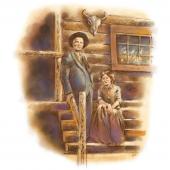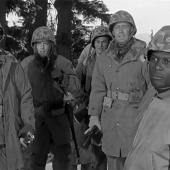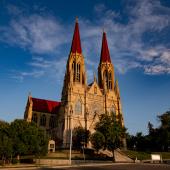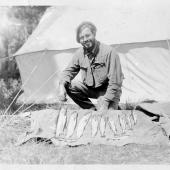Legacy of Montana Women Writers
Department Literary Lode -
Dorothy Johnson was the first women writer I ever met. It was in the 1960s, when she was teaching at the University of Montana’s School of Journalism after a 15-year editing career in New York. Described as a “little bobcat of a woman,” Johnson (1905-1984) wrote about the frontier west in seventeen books and fifty-two stories — three of which, The Hanging Tree, A Man Called Horse, and The Man Who Shot Liberty Valance became movies. In delightful contrast to the Girl Scout Troup leaders and symphony wives who comprised my images of womanhood in small-town Missoula, Johnson had dark black glasses, an acerbic speaking style, and she was famous for shooting a rattlesnake in her basement.
As women writers go, it wasn’t a bad introduction.

FEMMES FRONTIER
Women’s early work about Montana crackles with the energy of the early frontier. MARY RONAN, arrived with her family in Alder Gulch, shortly after the famous 1862 Grasshopper Creek gold strike. In Girl from the Gulches, she described the mining camp as populated by “rough-clad men with long hair and flowing beards” and echoing with the “sounds of brawls, insults and oathes (sic).” But it was also a place where she buys candy with leftover gold dust from sluice boxes and discovers “on the tumbled hills,” that “the primroses made pink splotches in early spring.” After marrying Indian agent Peter Ronan, she lived for 20 years in the Jocko Valley, where “the mountains rose so abruptly that they seemed to lean forward.” On an agent’s monthly salary of $150, Ronan entertained constantly, everyone from Indian councils to Irish earls, noting that “as long as I lived on the reservation, I was never again alone in my home with my own family.”
NANNIE ALDERSON (1860-1947) left her life as a southern belle in Virginia to move to a ranch in Birney, with her husband, Walt, in 1883, just five years before Montana’s statehood. Cowboys chasing stray calves and male couriers often stopped by the Alderson Ranch, where, as Nannie saysa, “she felt like a mother to the bachelors.” All called her “Mrs. Alderson,” just as she call her husband “Mr. Alderson” On the frontier, she noted, “I believe that we stuck all the more firmly to our principles of etiquette because we were so far from civilization.”
B.M. BOWER (1871-1940) who arrived in Montana in 1888, portrayed the isolation of ranch life in Lonesome Land, one of several successful novels, including Chip of the Flying U. When newlywed Val sees Cold Spring Ranch, it is not the small cottage where the “western breezes napped white curtains in the windows.” It is a shack, with a lean-to, a few straggling flowers, on a “wide, wide prairie.” The spring is “a stock-trampled pool of water and yellow mud.” Her question of her husband, Manley, is a vast understatement of her disappointment and determination: “Isn’t it all — deliciously — primitive?”
Then there’s MARY MACLANE (1881-1929). I like to introduce her when people point to women as a “civilizing” influence. Fiery, feminist, and openly bisexual at the crack of the twentieth century, Maclane shocked Butte with The Story of Mary MacLane, which sold over 100,000 copies. She described the town as a “promiscuous” mix of “all nationalities and stations... warped, distorted barren, having lived its life in smoke-cured Butte.” Casting her eye up and down the social ladder, she captures the delicate smell of “cocktails and whiskey-and-soda” from the “automobiles of the upper crust” and the “rolling, rollicking, musical profanity of the ‘old sod’ that falls more from the cigaretted lips of the 10-year-old lad than from his mother who taught it to him.”
FROM HOMESTEADS TO SUFFRAGE
From the 1920s to the 1940s, women writers were making their presence known in the state. Women were voting, attending college, and — at what was then known at Montana State University in Missoula — English Professor H.G. Merriam encouraged a number of women writers.
MAY VONTVER (1892-1990) who studied with Merriam, published a story, “The Kiskis,” in the university literary magazine, The Frontier in 1929 and it was reprinted world-wide. A Swedish immigrant and homestead teacher, Vontver tells the story about deep divisions in a homestead schoolhouse between the children of ranchers and the newly-arrived immigrants. Vontver who later became county superintendent of schools in Petroleum County, published a novel, the Mistress of Langston.
GRACE STONE COATES (1881-1962), The Frontier’s assistant editor under Merriam, is best known for her novel, Black Cherries. During the 1920s and 1940s, she wrote stories (“Wild Plums” her best known), poems, and another novel, Clear Title, from her home in Martinsdale. Her work explores with psychological acuity the stark realities of homestead life amid the beauties of the natural world. In “Portalucas in the Wheat,” from the same-named collection, she tells how a child discovers “a marvel in the wheat…Blossoms! A myriad of them, flaming silk/Of colors flaunted by the sun!” just as the harvest combines are about to descend. Her father instructs the combines to mow around them, “while driver muttered, brothers jested, gay/unstricken blossoms bravely cupped the sun.”
GWENDOLEN HASTE (1889-1979) edited the Scientific Farmer out of Billings with her father. Born in Illinois, Haste graduated from the University of Chicago in 1912 and won The Nation’s poetry prize in 1922. Her selected poems, (published by Ahsahta Press in 1976) cast a harsh light on women’s lives on ranches. Her poem, “Ranch in the Coulee,” describes the desperate loneliness of the woman in the “ranch house down a little draw” where she can see “an auto swirling dusty through the heat,/Or children trudging home on tired feet.” Finally, she must keep the “highroad always within sight” and if it is empty long, she “beat upon the pane and cried with fright.”
When Helena native FRIEDA FLIGELMAN (1890-1978) graduated from the University of Wisconsin in 1907, she returned home to picket for women’s suffrage. Her step-mother told her not to come home that night if she was going to continue her unladylike behavior. Fligelman continued and spent the night at a hotel, charging it to her father. After attending graduate school at Columbia, she worked as a sociologist before returning to Helena in 1948. In her poem, “Hall Bedroom Scholar,” from Notes for a Novel: The Selected Poems of Frieda Fligelman, she writes of a new kind of pioneer, a woman scholar, roaming among her bookshelves “like a pioneer gazing on/broad prairies/sees the clean-laid furrows of/plotted fields/As ripening grain.”
WOMEN AWAY FROM THE RANGE
MILDRED WALKER (1905-1998) wrote 13 novels in Great Falls from 1933 to 1950. Best known for Winter Wheat, The Curlew’s Cry, and If A Lion Could Talk, Walker came to Montana as the wife of a young doctor Ferdinand Ripley Schemm, with an arrangement that she would write and he would pursue medicine. She lived a divided life: doctor’s wife and distant mother on one hand; writer on the other. Her daughter, poet Ripley Schemm, said her mother wrote and attended Junior League meetings — her published books closeted away in her study. Nevertheless Walker’s complex female characters reveal her keen insights about women’s lives in Montana that so often tottered on the vagaries of weather, crops, and the fortunes of their men.
By the 1960s, the confluence of the women’s movement and the environmental movement sparked Montana women to question not only how their stories were told, but how they wanted to shape their stories. Hence Dorothy Johnson who wanted nothing more on her tombstone, than words that said, simply: “PAID.”











Leave a Comment Here